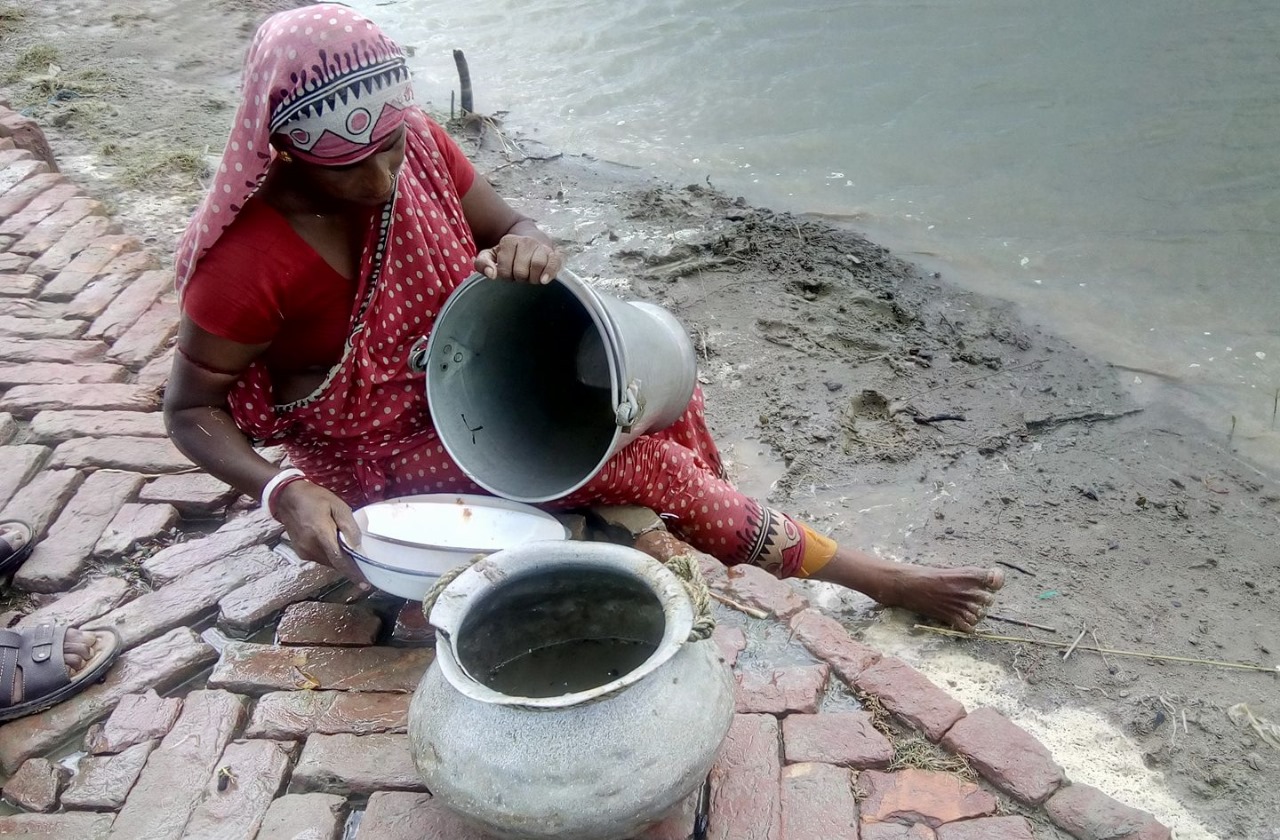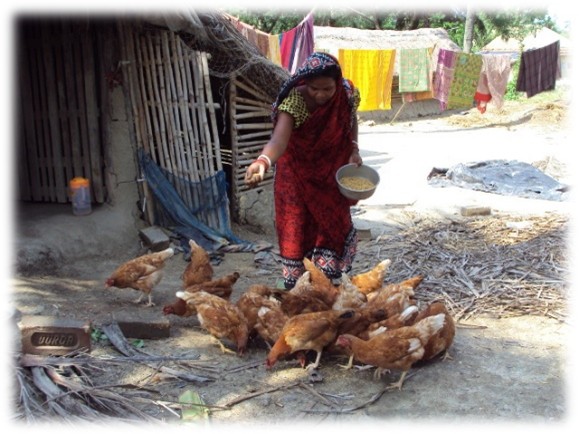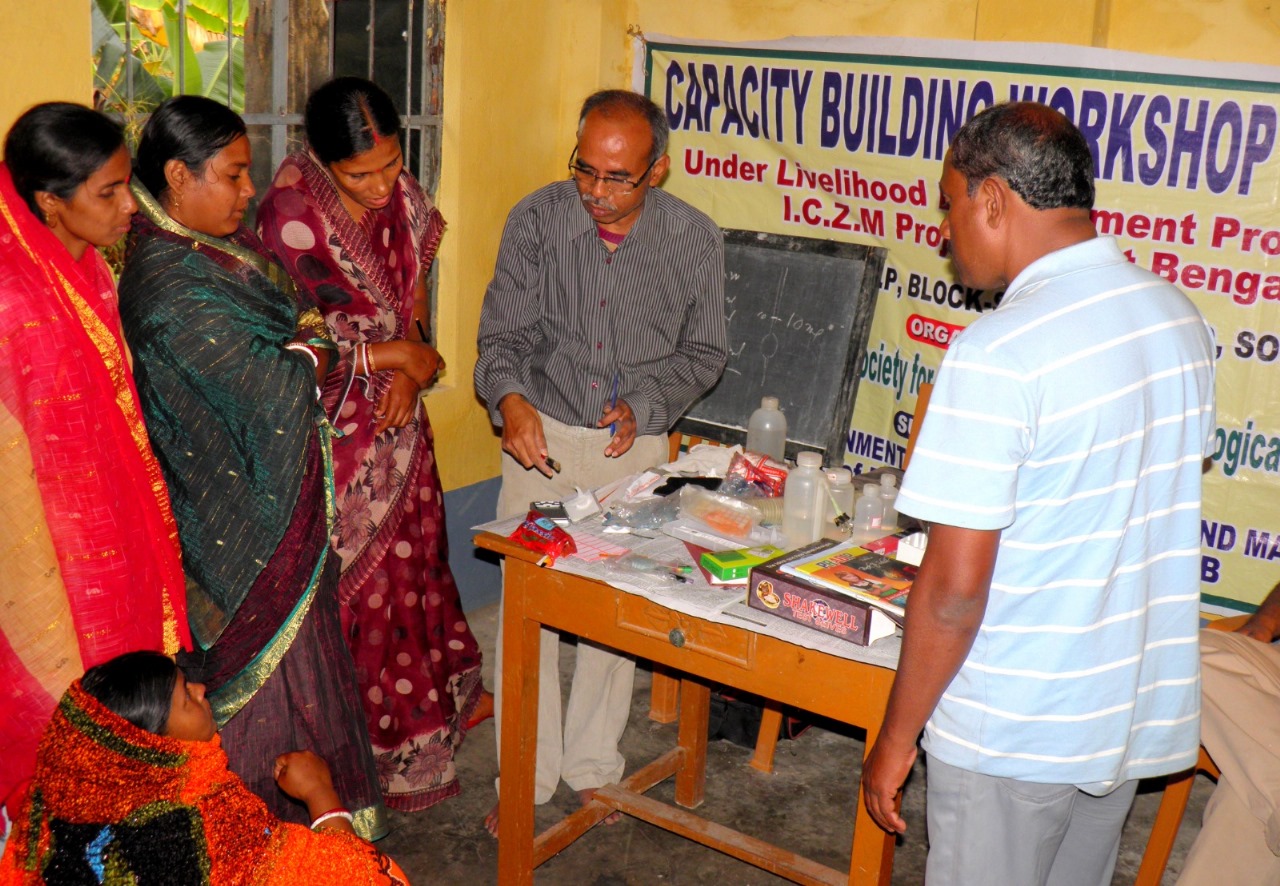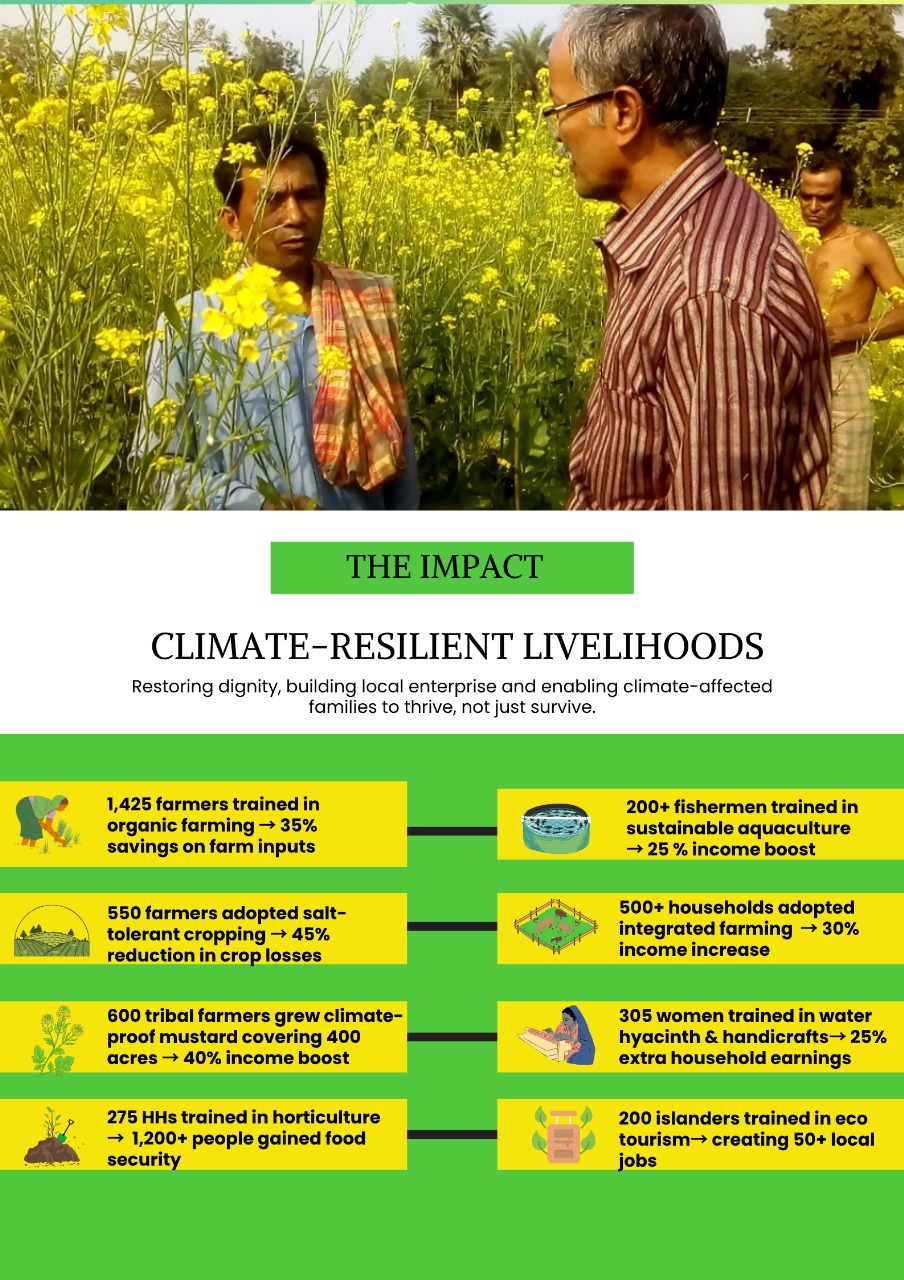

The Indian Sundarban region, home to 4.5 million of the world’s most vulnerable people and the largest single mangrove forest in the world, is increasingly at threat from catastrophic impacts of climate change, contributing to the absence of employment opportunities, the destruction of property from extreme weather events and the loss of vital mangroves and land from sea level rise. With homes and livelihoods under threat, many are left with no choice but to migrate elsewhere. According to the World Bank, almost 80% of households in the Sundarbans pursue livelihoods that involve inefficient agriculture, fishing and aquaculture production methods. Dependence on the land and natural resources paired with a lack of alternative employment opportunities means livelihoods are extremely vulnerable to changing climatic conditions
Salinisation is threatening agriculture. Fishermen are impacted by the decline in fish populations. Forest-based livelihoods are adversely impacted by changes in the composition of mangrove species, which is reducing the value of standing timber and honey production. A study in the Indian Sundarbans found that 62% of the workforce has lost their original livelihoods and have been forced to rely on much more uncertain incomes. With the Bay of Bengal warming at 0.12°C per decade (IMD, 2022), cyclones are becoming more intense and frequent, leaving communities with little time to recover between disasters. The repeated loss of assets has trapped many in a cycle of poverty, with limited access to credit or alternative livelihoods.

Even though the impacts of climate change put their livelihoods at greater risk, some households continue to live in vulnerable locations due to high land prices and a lack of employment opportunities elsewhere. Due to a lack of job opportunities, others need to migrate to seek out employment, temporarily or sometimes permanently.
Young men and women have had to leave for nearby cities, or even states over 1,000 kilometres away. There they face a precarious existence as daily wage labourers and contract workers at construction sites and factories. Some estimates suggest that roughly 60% of the male workforce in the Indian Sundarbans has migrated. Migration has also increased the poverty of the population left behind since it takes considerable time for low-skilled migrant family members to save sufficient funds to send back home.
Rising Salinity and Declining Agricultural Productivity
Faces severe salinity intrusion due to rising sea levels and cyclonic storm surges. According to the ICAR-Central Soil Salinity Research Institute (2022), over 40% of arable land in the Sundarbans has become saline, drastically reducing crop yields. Traditional paddy varieties, once the staple for farmers, are failing, leading to a 30-40% decline in agricultural income (World Bank, 2021). This has forced many smallholder farmers into debt or migration, further destabilizing rural economies. Cyclones like Amphan (2020) and Yaas (2021) have caused catastrophic damage, submerging farmlands and destroying homes. A UNDP report (2023) estimates that 70% of standing crops were lost during these disasters, pushing thousands into food insecurity.
Collapse of Fisheries and Mangrove-Dependent Livelihoods
Fishing and crab collection, which support 60% of households in the Sundarbans, are under threat due to climate-induced ecosystem changes. Rising salinity and habitat destruction have reduced fish stocks, with some communities reporting a 50% drop in catches (WWF-India, 2022). The deterioration of mangroves — estimated at a 1.3% annual decline in forest density — disrupts honey collection and biodiversity-based livelihoods. Loss of 110 km² of mangroves between 2000 and 2020 has reduced ecosystem services valued at USD 3.3 billion in the last 30 years.
Limited Livelihood Diversification and Pressure on Forest Resources
Over half of the population depends on climate-sensitive farming; only ~54% diversify into wage labor, aquaculture or livestock. Low institutional support (77% of farmers report inadequate training) and fragile cooperatives (29% participation) exacerbate vulnerabilities. Without resilient systems, households sink into debt or are forced to migrate. The decline of mangrove biodiversity harms ecosystem services. Nearly 3.5 million people rely on products like timber, honey, and fish. As climate impacts shrink mangrove cover and fisheries, forest dependency intensifies, often resulting in unsustainable harvesting, human-wildlife conflict, and ecological collapse.
Gender Disparities and Social Vulnerabilities
Women, who form 80% of the agricultural workforce in the Sundarbans, bear the brunt of climate impacts. With men migrating for work, women struggle with increased labor burdens, reduced income and limited access to decision-making. A UN Women (2023) study found that only 15% of women in the region have control over financial resources, making recovery from climate shocks even harder.
SEED’s Climate-Smart Livelihoods Approach aims to enhance the resilience of vulnerable communities in the Sundarbans by promoting sustainable agricultural practices, diversifying income sources, and improving access to renewable energy. This holistic strategy addresses the interconnected challenges of climate change, biodiversity loss, and social inequality.

SEED promotes the adoption of saline- and flood-tolerant crop varieties and short-duration vegetables suited to degraded soils. These seeds are not just distributed but introduced through structured training programmes that include the use of organic compost, bio-pesticides, rainwater harvesting techniques and drip irrigation. These practices are enhancing productivity, minimizing crop loss and improving soil health across affected regions.
To reduce dependency on single-income sources, SEED has introduced integrated livelihood models combining homestead poultry, duckery, piggery, goat rearing, and backyard horticulture. Communities receive hands-on training in managing livestock, composting, and fruit tree plantations suited to the coastal climate. These interventions are especially empowering for women-led SHGs and youth, providing income security even during agricultural downturns.


SEED supports the development of small-scale aquaculture through the rejuvenation of community ponds and the training of local fish farmers. Alongside, eco-tourism initiatives and cottage industries such as handloom weaving and nature-based handicrafts using water hyacinth are being promoted. These activities not only create alternative livelihood avenues but also preserve cultural knowledge and encourage community stewardship of natural resources.
SEED is strengthening the capacities of SHGs, CIGs and FPOs through training in financial and supply chain management, collective enterprise development and market linkage facilitation. Youth cadres are also being trained in extension services and the upkeep of systems. By connecting producers to government schemes and digital platforms, SEED ensures sustainability and scalability of its interventions.





Subscribe to the SEED Newsletter — and be part of the change!